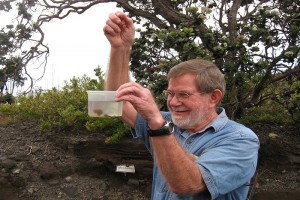VOLCANO WATCH: HVO Geologist Receives Two Prestigious Awards

During a 2015 field trip with Franklin and Marshall College students, Don Swanson, a geologist at the USGS Hawaiian Volcano Observatory, demonstrates that reticulite (frothy basalt, less dense than pumice, explosively erupted in lava fountains) sinks, rather than floats, in water due to its high permeability. Swanson is the recipient of two prestigious awards honoring his career as a research volcanologist and science communicator. Photo courtesy of Stan Mertzman, Franklin and Marshall College.
USGS Hawaiian Volcano Observatory geologist Don Swanson was recently named as the recipient of two prestigious awards.
In May 2016, he will receive the U.S. Geological Survey’s Shoemaker Award for Lifetime Achievement in Communications. This annual award honors a USGS scientist who has created excitement and enthusiasm for science among non-scientists and recognizes the recipient’s lifetime contributions to science through effective communication skills.
During the Geological Society of America Annual Meeting in September 2016, Don will receive the GSA Mineralogy, Geochemistry, Petrology, and Volcanology Division’s Distinguished Geologic Career Award. This annual GSA award goes to an individual who has made distinguished contributions, with emphasis on multidisciplinary and field-based approaches, in one or more geologic fields of research throughout his/her career.
The GSA award citation states, in part, that “as a field-focused geologist, Dr. Swanson combines both strong disciplinary impact in igneous processes and volcanic hazards with unusually passionate public outreach.” It goes on to say, “field-based researchers rarely achieve the same impact in the literature as their academic counterparts, yet Dr. Swanson’s publication record is outstanding and his work has significantly directed volcanic hazards policy.”
Don’s career as a USGS volcanologist spans more than 50 years, 6 states, and 4 countries.
On the U.S. mainland, Don mapped and studied the Columbia River basalt, a huge lava field that erupted from 17 to 6 million years ago and inundated much of eastern Washington and parts of Oregon and Idaho. Don also served as lead geologist for the USGS Cascades Volcano Observatory in Vancouver, Washington, where he played a critical role in the monitoring and documentation of the cataclysmic eruption of Mount St. Helens in 1980. Six years later, he became CVO’s Scientist-in-Charge.

Don Swanson talks about Kīlauea Volcano’s 1969–1974 Mauna Ulu eruption with geology students from Franklin and Marshall College during their 2015 field trip to Hawai‘i Volcanoes National Park. Photo courtesy of Stan Mertzman, Franklin and Marshall College.
Don’s first stint at the Hawaiian Volcano Observatory was as a staff geologist in 1968–1971, during which he documented Kilauea Volcano’s Mauna Ulu eruption. He returned to Hawai‘i in 1996, and for nearly 8 years, he was HVO’s Scientist-in-Charge. In 2004, Don rotated back to a research scientist position at HVO, where he continues to unravel the geologic history of Kilauea.
Throughout his USGS career, Don has been an enthusiastic communicator of volcano science and hazards. His outreach contributions have spurred public interest in volcanoes and encouraged students to pursue earth science careers.
As Scientist-in-Charge, Don supported CVO and HVO staff in their development of museum and visitor center displays that have been seen by hundreds of thousands of people. For example, a traveling exhibition on Cascade and Hawaiian volcanoes, created by the USGS in collaboration with the Smithsonian Institution, was showcased in 11 major cities.
Early on, Don saw the potential of the Internet, and made HVO’s Web presence a priority of his leadership tenure. Using the website to post daily updates about Kilauea’s eruption, Don captivated readers around the world with his observations, which were presented in a consistent style that was not overly technical but still maintained scientific rigor. The updates also conveyed his passion and curiosity as a scientist wanting to discover more about Kilauea’s history.
Don’s prose has also graced USGS Fact sheets, USGS General Interest Products, and numerous newspaper columns, all of which have been well-received by the public.
As a speaker, Don’s experience and eloquence has led to countless media interviews and hundreds of diverse community forums to his credit. His recent presentations have focused on his ongoing research into the serious hazard implications of Kilauea’s explosive history, as well as the links between Native Hawaiian culture and volcano science.
Don is committed to knowledge transfer. He has trained hundreds of National Park Service and U.S. Forest Service interpreters on how to convey the geology and hazards of Hawaiian and Cascade Range volcanoes to the public. He is also a prolific field trip leader for undergraduate and graduate geology students wanting to learn about Kilauea.
Scientists and non-scientists alike have reaped the rewards of Don’s half-century of research, visionary communication style, and energetic approach to education and outreach. The USGS and GSA awards are well-deserved tributes to his career and dedication.
Congratulations, Don!
Volcano Activity Updates
Kilauea continues to erupt at its summit and East Rift Zone. During the past week, the summit lava lake level varied between about 23 and 45 m (75–150 ft) below the vent rim within Halema‘uma‘u Crater. On the East Rift Zone, scattered lava flow activity remains within about 6 km (4 mi) of Puʻu ʻŌʻō and is not currently threatening nearby communities.
Mauna Loa is not erupting. Seismicity remains elevated above long-term background levels, but the earthquake rate remained stable this past week. GPS measurements show continued deformation related to inflation of a magma reservoir beneath the summit and upper Southwest Rift Zone of Mauna Loa, with inflation recently occurring mainly in the southwestern part of the magma storage complex.
No earthquakes were reported felt on the Island of Hawai‘i during the past week.
Volcano Watch is a weekly article and activity update written by scientists at the U.S. Geological Survey`s Hawaiian Volcano Observatory.















